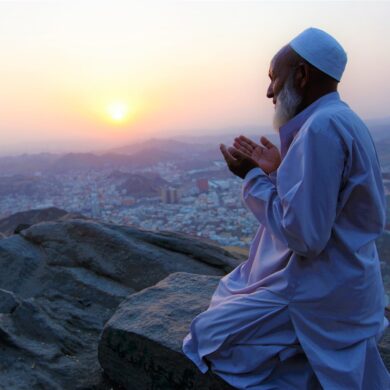In the Book of Prophet Daniel (PBUH), which contains narratives, prophecies, and visions, we find a remarkable chapter, Chapter 7, where Prophet Daniel (PBUH) receives a prophetic vision from Allah (Subhanahu Wa Taalla – SWT). This vision reveals crucial insights about future events and emphasizes the ultimate sovereignty of Allah (SWT).
The chapter begins with Prophet Daniel’s (PBUH) vision of four powerful beasts emerging from the sea. Prophet Daniel (PBUH) says, “I saw in my vision by night, and behold, the four winds of heaven were stirring up the Great Sea. And four great beasts came up from the sea, each different from the other” (Daniel 7:2-3). This vision is connected to King Nebuchadnezzar’s Dream, which is mentioned in Chapter 2 of the same Book.
In this vision, the four beasts represent four successive world empires: Babylon, Medo-Persia, Greece, and Rome. As Prophet Daniel (PBUH) explains in verse 17, “Those great beasts, which are four, are four kings which arise out of the earth.” This understanding aligns with historical evidence and corresponds to the prophetic framework found in Chapter 2.
Let’s examine each beast and its significance:
- The Lion with two wings – Daniel 7:4
(Babylon – 605 to 539 BC)
The first beast represents the kingdom of Babylon, with Nebuchadnezzar being its best-known ruler. In the Book of Prophet Daniel (PBUH) chapter 2, Babylon is symbolized by the golden head of the statue seen in the king’s dream. Babylon was renowned for its immense wealth. The lion, symbolizing the king of beasts, is associated with Babylon, while the eagle’s wings represent its rapid conquest. However, the prophecy indicates that the wings would be torn off, signifying the removal of Babylon’s power.
- The Bear with 3 ribs in its mouth – Daniel 7:5
(Medo-Persia – 538 to 331 BC)
The second beast represents the Medo-Persian Empire, formed through a union between the Medes and the Persians. This empire conquered Babylon and gained power. In the Book of Prophet Daniel (PBUH) chapter 2, Medo-Persia is represented by the silver chest and arms of the statue. The text describes this beast as one that devours much flesh, signifying the empire’s cruelty. The three ribs in its mouth represent the territories of Libya, Egypt, and Babylon, which were conquered with voracity and violence.
- The Leopard with 4 Wings and 4 Heads – Daniel 7:6
(Greece – 331 to 168 BC)
The third beast represents the Greek Empire under the leadership of Alexander the Great. This leopard, depicted with four wings, symbolizes the incredible speed of Greek conquests. Alexander, known as “the Great,” was a skilled military strategist who conquered vast territories. In the Book of Prophet Daniel (PBUH) chapter 2, Greece is represented by the bronze belly and thighs of the statue. After Alexander’s early death, his empire was divided among his four generals, represented by the four heads on the leopard.
- Terrible and dreadful beast with iron teeth and 10 horns – Daniel 7:7
(Rome – 168 BC to 476 AD)
The fourth beast greatly astonishes Prophet Daniel (PBUH), being fierce and terrifying. It has iron teeth, representing its ability to tear apart and devour its victims. This kingdom, marked by a concentration of power, is depicted with ten horns. In the Book of Prophet Daniel (PBUH) chapter 2, Rome is represented by the iron legs of the statue. The period of Roman dominance was characterized by violence and cruelty. The ten horns indicate that the empire would eventually be divided into ten nations, giving rise to modern-day Europe.
Additionally, among the ten horns, Prophet Daniel (PBUH) sees another horn that arises and uproots three horns. This small horn grows to be significant, with the eyes and mouth of a man and speaks pompous words and blasphemies (Daniel 7:8-11). This horn represents the religious aspect of Rome. The chapter indicates that this religious power would attempt to place itself in the position of God, change times and laws, and persecute the faithful.
Continuing the vision, Prophet Daniel (PBUH) witnesses the Ancient of Days (that is an expression describing Allah (SWT), which indicate His Sovereignty and Eternity) taking His seat on a fiery throne, and the judgment begins (verse 9-10). This scene represents the heavenly judgment, where Allah (SWT) presides over the destiny of nations and individuals.
Further, Prophet Daniel (PBUH) sees the Son of Man coming with the clouds of heaven to the Ancient of Days, as he says, “I was watching in the night visions, and behold, One like the Son of Man, coming with the clouds of heaven!” (verse 13). This Son of Man refers to Isa Al-Masih (His peace be upon us), who will receive dominion, glory, and an everlasting kingdom (verse 14). This event points to Isa’s (His peace be upon us) second coming to Earth and the establishment of an eternal kingdom that will triumph over the kingdoms of this world, and all evil will be destroyed.
The interpretation of the vision is given to Prophet Daniel (PBUH) by the angel Gabriel (Jubraiel). Despite the consecutive world empires and the rise of the little horn within the Roman Empire to persecute Allah’s (SWT) people and seek to change times and laws, the judgment will be established, and the saints will receive the Kingdom (verse 22).
This prophetic dream holds great importance and shows us the faithfulness and sovereignty of Allah (SWT) throughout the history of the world. It gives hope to believers that despite the challenges we may face, Allah’s (SWT) ultimate victory is assured, and His everlasting kingdom will be established under the reign of Isa Al-Masih (His peace be upon us).


